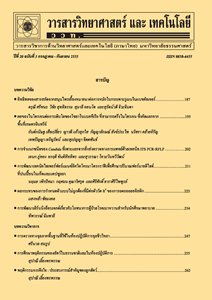การประเมินการกักเก็บคาร์บอนเหนือพื้นดินของสวนยางพาราโดยการประยุกต์เทคโนโลยีการสำรวจระยะไกล กรณีศึกษา จังหวัดระยอง
Main Article Content
Abstract
บทคัดย่อ
การศึกษาครั้งนี้มุ่งเน้นเพื่อประเมินการกักเก็บคาร์บอนเหนือพื้นดินของสวนยางพารา โดยการประยุกต์เทคโนโลยีการสำรวจระยะไกลเพื่อช่วยในการจำแนกพื้นที่ปลูกยางพาราออกเป็น 2 ช่วงอายุ ด้วยกัน นั่นคือ ช่วงก่อนผลิตน้ำยาง (0-7 ปี) และช่วงอายุผลิตน้ำยาง (8-25 ปี) ซึ่งการศึกษาครั้งนี้ได้ใช้วิธีวิเคราะห์เนื้อภาพ (texture analysis) ร่วมกับการวิเคราะห์โดยใช้ดัชนีพืชพรรณ (NDVI) โดยใช้ข้อมูลภาพถ่ายจากดาวเทียม LANDSAT 8 OLI เดือนธันวาคม ปี พ.ศ. 2557 เพื่อใช้ในการจำแนกพื้นที่ปลูกยางพารา ในส่วนของปริมาณการกักเก็บคาร์บอนของยางพารานั้นประเมินจากสมการมวลชีวภาพ (allometric equation) โดยการวัดเส้นผ่านศูนย์กลาง และความสูงของยางพาราในพื้นที่ศึกษา และนำมาเปรียบเทียบระหว่างจำนวนคาร์บอนที่ยางพารากักเก็บได้กับปริมาณน้ำที่ยางพาราใช้ (water footprint) ผลการศึกษาพบว่าจังหวัดระยองมีพื้นที่ปลูกยางพาราจำนวน 766,133.30 ไร่ หรือ 122,581.33 เฮกตาร์ โดยแบ่งเป็นช่วงก่อนให้ผลผลิต 74,008.55 ไร่ หรือ 11,841.37 เฮกตาร์ และช่วงให้ผลผลิต 692,124.75 ไร่ หรือ 110,739.96เฮกตาร์ ซึ่งคิดเป็นจำนวนการกักเก็บคาร์บอนทั้งหมดได้ 3,404,834.96 ตันคาร์บอน โดยแบ่งเป็นช่วงก่อนและช่วงเก็บน้ำยาง 7,638.79 และ 3,397,196.17 ตันคาร์บอน ตามลำดับ
คำสำคัญ : ยางพารา; การกักเก็บคาร์บอนเหนือพื้นดิน; การวิเคราะห์เนื้อภาพ; และการสำรวจระยะไกล
Abstract
This study focuses on above ground carbon stock estimation of Para rubber plantation at Rayong province by applying remote sensing technique to classify Para plantation. Para plantation is divided into 2 classes. The first is young stage or the rubber which less than 7 years old and another is harvest stage which the age more than 7 year. Moreover, texture analysis technique is used to Para rubber classification process. In addition, this study uses NDVI combine with texture analysis to separate vegetation area from others land cover. LANDSAT 8 OLI on December 2014 is used in this study. In the part of carbon stock estimation, data collection is important. Diameter and height (DBH) are collected in data collection at field study site. DBH is used in allometric equation to estimate biomass and calculate carbon stock later. Moreover, this study compares the value of carbon stock with water footprint to indicate environmental efficiency of Para rubber. The result of this study indicates that there is Para rubber plantation area 766,133.30 rai or 122,581.33 ha that 74,008.55 ha is young stage and 11,841.37 ha is harvest stage. The total carbon stock is 3,404,834.96 ton C which young stage and harvest stage are 7,638.79 and 3,397,196.17 ton Carbon respectively.
Keywords: Para rubber; above ground carbon stock; texture analysis and remote sensing

